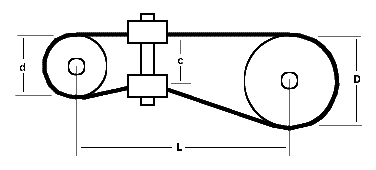POBCO SnapIdle® Chain Tensioner
Selection Criteria
 Standard Criteria
Standard Criteria
R1 = D/d = Sprocket Ratio
R2 = D/L = Drive Aspect Ratio
R3 = c/d = Constant Ratio
R1 must be less than 4
R2 should be less than
or equal to 0.5
R3 should be less than
or equal to 0.85
 Multiple Sprocket Applications
Multiple Sprocket Applications
Standard Criteria
H + d1 + d2
2
d3
If the result is less than 4, use Standard Criteria

Selection Constraints
VELOCITY LIMITS
Oil bath: Chain speeds should not exceed 2,500 F.P.M.
Standard lube: Chain speeds should not exceed 1,800 F.P.M.
Bone dry: Chain speeds should not exceed 800 F.P.M. ENVIRONMENT
Temperature: Maximum operating range of any standard POBCO Snapidle unit is two hundred degrees F. For temperatures above two hundred degrees F, use the PSI-HT Series Snapidle (Not to exceed 450° F).
Chemicals: Metal carriers are stainless steel. Screws and pins are zinc plated carbon steel. Wingnuts are die cast zinc. Bolts are zinc plated carbon steel with nylon inserts. All stainless steel (300,304) construction is available upon request.
Environment: In extreme environment (i.e. abrasive grinder dust, foundries, gypsum facilities, dry glass, etc.) especially in a lack of lubrication situation, the wear on the carrier will be greatly enhanced. In the case where the standard POBCO Snapidle does not provide adequate life, the PSI-XH Snapidle series should be used.
Reversing Drives and Orientation: The POBCO Snapidle series has no limitation on the direction of rotation. The POBCO Snapidle may be used in any chain drive attitude.
MISALIGNMENT
The POBCO Snapidle series can tolerate any misalignment compatible with a roller chain drive and, in most applications, will allow a roller chain drive to operate with a larger misalignment. Misalignments in which the plane of one sprocket is rotated relative to the plane of the second or in which the plane of one sprocket is moved laterally relative to the other sprocket, or a combination of the two, can be tolerated.
TENSIONING & IDLING SYSTEMS
"Traditional" tensioning or idling devised face the following problems:
1. Too much tension in a drive causes excessive belt, chain and bearing wear.
2. Too little tension in a drive allows belt slippage or chain vibration, resulting in loss of power and additional wear.
3. All traditional idlers should be installed on the slack side of the drive.
4. Traditional v-belt idlers should be used on the inside of the belt, which results in a corresponding horsepower loss
due to the reduced arc of contract.
5. Idlers used on the outside of a drive should be located approximately 1/3 of the center distance from the small
sheave, pulley or sprocket, or the drive will suffer detrimental effects.
6. Chain wrap or pulley wrap must be 120 degrees of the small sprocket or sheave in order to have adequate drive life
and in order not to suffer horsepower loss.
7. Traditional idling sprockets add increased wear to the drive.
8. The system must be mounted, maintained and lubricated.